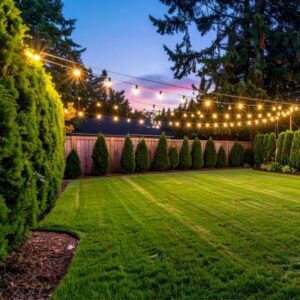When the sun sets earlier and natural light dwindles, buyers may subconsciously feel a home is darker, less inviting, or harder to live in. In fact, shorter days challenge a home’s perceived spaciousness and warmth. Studies show that ambient conditions – including lighting and scent – influence emotion, memory, and decision-making. Integrating thoughtful fall home staging means more than arranging furniture: it’s about creating experience.
A well-lit space fosters clarity and openness, while a gentle, welcoming scent evokes “home” before the buyer even speaks. Using scent and lighting paired together helps trigger emotional connection and comfort rather than just visual appeal.
By focusing specifically on the fall home staging, you’re aligning with buyer expectations: they’re looking for spaces that feel ready to host holiday gatherings, cozy evenings, and transitional living. Lighting and scent become a strategic asset rather than an afterthought.
Assessing Your Existing Lighting Setup
Before you stage your home, take a walk through your home at sunset or during twilight. Ask: are there dark corners? Are certain rooms relying only on overhead fixtures? Here’s a quick audit:
- Check all light bulbs: replace any burnt-out or mismatched units.
- Layer sources: table lamps, floor lamps, wall sconces in addition to ceiling lights.
- Evaluate outdoor & entry lighting: when dusk hits, is your front entry inviting or shadowy?
The goal: ensure that each visual “zone” the buyer moves through is consistently bright, safe, and intentional. Dark spots can reduce perceived square footage and dampen interest. Mirror placement opposite windows can amplify the remaining natural light.
Lighting Strategies for Better Fall Home Staging
Layered lighting: ambient, task & accent
Rather than relying only on overhead lights, create depth with three layers:
- Ambient: the main room light
- Task: reading lamps, desk lights, counters
- Accent: wall sconces, under-cabinet lighting, spotlighting focal features
In fall showings when daylight is limited, the accent layer helps guide a buyer’s eye to children’s spaces, picking spots, and key architectural details.
 Choosing the right color temperature & bulbs
Choosing the right color temperature & bulbs
Opt for “warm white” LEDs (2700-3000 K) rather than harsh daylight bulbs. Warm light reads as cozy and welcoming.
Outdoor & entry lighting for evening showings
With shorter days, many showings occur near dusk. Pathway lights, lit porch lights, and well-lit house numbers all signal care and security.
Scent Strategy that Enhances Without Overwhelming
Scent is powerful — it evokes memories instantly. But in staging, the rule is: subtle is better. Overpowering “pumpkin-spice everything” can feel cliché or even turn buyers off.

- Soft cedarwood or sandalwood
- Linen or fresh cotton
- Light apple-cinnamon (sparingly)
Delivery: reed diffusers, lightly scented candles (unlit at showings for safety) or discreet wax melts. Place one scent source near the entry or kitchen to make first impressions count.
Avoid strong floral, overly sweet, or gender-specific scents that might distract. The right scent should imply well-maintained home and inviting living, not scream “seasonal décor”.
Integrating Lighting + Scent for a Unified Experience
Think of the buyer’s path through your home as a journey: the entry → living room → kitchen/dining → outdoor space. At each transition, lighting and scent should subtly shift to match the mood:
- Entryway: gentle warm light, a hint of scent (linen or soft wood) to welcome
- Living room: layered lighting showing seating zones, no strong scents
- Kitchen/dining: bright task lighting, or perhaps a whisper of fresh scent in the pantry or near the dining table
- Outdoor/porch (evening): lantern or string lights, clear pathways, scent moves to outdoor freshness or neutral
This creates cohesion and tells the story: you can live here, now and into the season. That deeper narrative is what separates good staging from great.
Fall Home Staging Tips for Shorter Days

- Open all curtains/blinds during showings and clean windows to maximize any natural light.
- Introduce textures and color swaps: heavier throws, textured pillows, warm accent tones like rust, olive, or deep charcoal — but keep décor minimal to avoid overwhelming.
- For yards/patios: highlight their usability even as evenings come earlier — set up chairs with a throw, lanterns lit (battery-operated if needed), ensure walkways are clear and safe.
- Track the showing time: if many showings happen near dusk, consider adding motion sensor lights or accent lighting outside.
Common Fall Home Staging Mistakes & How to Avoid Them
- Overpowering scents: Too strong means buyers think you’re masking something.
- Under-lighting: Relying only on overhead lights makes rooms look flat and smaller.
- Over-the-top decor: Full seasonal themes distract rather than support. Example: a mantel covered in pumpkins and garlands might overshadow architectural features.
Avoid these pitfalls by keeping staging tailored, intentional, and timeless.
Actionable Checklist for Home Sellers, Realtors & Builders
When your budget is modest, focus on entry, lighting, and scent — these yield high impact. Builders and realtors showing model homes may allocate more budget for layered lighting and outdoor living as key differentiators.
Fall presents a unique opportunity in the real estate market. The changing light, cooler evenings, and buyer mindset all converge. By leveraging home staging strategies centered on lighting and scent, you can turn the challenge of shorter days into a strategic advantage. Combining ambient, task, and accent lighting with a subtle scent cue creates a space that feels cared-for, inviting, and ready to live in — not just view.
Whether you’re preparing your own home for sale, guiding clients as a realtor, or showing new construction as a builder, this playbook offers the tactics you need. Then comes the call-to-action: schedule a staging consultation, install layered lighting, or select your scent focal point — whichever fits your timeline and budget. Warm, bright, inviting — your listing is ready to shine this fall.

 Choosing the right color temperature & bulbs
Choosing the right color temperature & bulbs